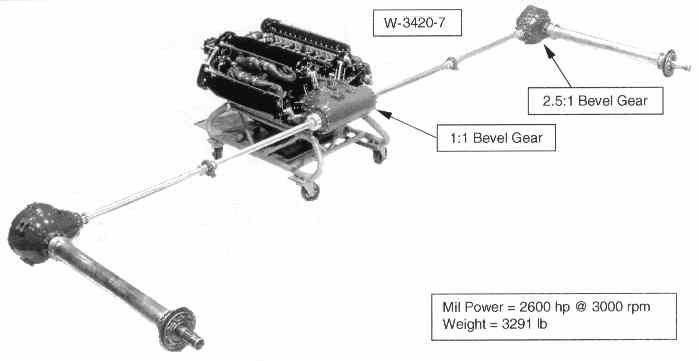
Allison W-3420s
by John Leonard
| Thanks to the generosity of the Rolls-Royce Heritage Trust Allison Branch, Inc., the AEHS is pleased to reprint a series of John Leonard's feature articles from the Allison Branch newsletter. The Rolls-Royce Heritage Trust is one of the world's great engine information resources. Memberships are reasonably priced and provide a number of benefits. For more information, see the Rolls-Royce Heritage Trust web pages under the home page Links tab. |
Back in the 1940s you couldn't accuse Allison engineers of not thinking outside the box. The pictures below show two versions of the W-3420 designed for unconventional arrangements of engines and propellers.
The W-3420‑23 is the engine used in the Fisher P‑75. As in the P‑39 and the P‑63, the engine was mounted behind the pilot with drive shafts running up to the gear box and propeller in the nose of the aircraft. This arrangement put the engine over the wing thus reducing the weight of structure required to support it, and put the pilot ahead of the wing giving him better visibility both over the nose and over the sides. There were 10 1 of these engines built along with 19 others with different dash numbers but with a similar configuration. In 1944 Fisher had a contract to build 2500 P‑75s, but only 13 actually flew. The last one to fly is now in the Air Force Museum in Dayton, Ohio.
The W-3420‑7 was another arrangement for keeping the engine over the wing in the fuselage, but in this case it would allow the propellers to be on the wings in small, low drag, nacelles. This general configuration was proposed with either tractor or pusher propellers, and either propeller could run left or right hand, whichever the customer preferred. It was considered by Bell with pusher props for a follow‑on to its XFM‑1. McDonnell Aircraft's first aircraft proposal in 1939 was for a long range fighter powered by either an Allison W-3420 or a P&W H-3130 buried in the fuselage and driving two pusher propellers aft of the wing through extension shafts and angle gear drives. Only one W-3420‑7 was built, and it never flew.
The W-3420 combined two V1710s into one engine. Many parts were common between the two engines, although some parts were obviously different. Both of the engines shown below had two crankshafts rotating in opposite directions, although in some versions of the engine they rotated in the same direction.


Copyright © 2001 Rolls-Royce Heritage Trust Allison Branch, Inc.